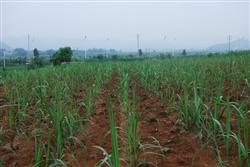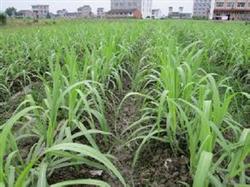Nutritional requirements and fertilization of Sugarcane

Sugarcane has a long growing period and high biological yield, so it is an economic crop that needs a large amount of fertilizer. according to research, each ton of raw sugarcane needs to absorb nutrients from the soil: nitrogen (N) 1.5kg, phosphorus (P2O5) 1.5kg, potassium oxide (K2O) 2.5kg, CaO 0.5kg. The main characteristics of fertilizer requirement of sugarcane are as follows: 1. The growth period of sugarcane is long, the yield is high, and the consumption of nutrients is higher than that of other crops. The results showed that when planting sugarcane in spring with a growth period of 10 to 11 months, the aboveground uptake of nitrogen (N) 8.10-11.53 kg, phosphorus (P2O5) 4.10-8.85 kg and potassium (K2O) 10.03-13.65 kg per mu of raw sugarcane. two。 The law of fertilizer absorption of unbalanced sugarcane is "less at both ends and more in the middle". In the seedling stage, the demand for fertilizer is urgent but the absorption is less, and the demand for nitrogen is slightly more, followed by phosphorus and potassium; in the tillering stage, the fertilizer requirement increases gradually, and the absorption of the three elements accounts for about 10%-20% of the whole period; entering the elongation stage, the absorption of the three elements increases greatly, accounting for more than 50% of the whole period, when sugarcane has the highest utilization rate of light and nutrients in the high temperature, rainy and bright season, which is the key fertilization period. After entering the mature stage, the fertilizer requirement of sugarcane decreases gradually, but it still absorbs a considerable amount of fertilizer, of which nitrogen fertilizer is more, accounting for 30% and 40% of the whole period. 3. The transfer of nitrogen, phosphorus and potassium in the plant tissue the three elements absorbed in the early stage of sugarcane growth can be stored in the fresh tissue. With the latent growth of the plant age, the withered and old leaves can transfer the nutrients to the fresh leaves, shoots and stems before losing their physiological function for the vegetative growth of these tissues. According to the nutritional requirements and characteristics of sugarcane, high-yield cultivation and fertilization should be carried out according to the principles of "combination of nutrition and growth needs, combination of organic fertilizer and inorganic fertilizer, combination of long-acting fertilizer and quick-acting fertilizer". (1) attach importance to the application of organic fertilizer and create conditions for a wide range of organic matter is one of the main indicators to evaluate sugarcane soil fertility. Generally speaking, the more organic matter in the soil, the higher the fertility. In sugarcane cultivation, stable manure and compost filter mud are all good organic fertilizers. Organic manure should be used as base fertilizer, generally using 1500 kg per mu, which is evenly applied on both sides of seedlings or on seedlings, and then chemical fertilizer is applied to cover the soil on the compost. Conditional sugarcane areas should actively intercropping green manure and legume crops in sugarcane fields, and green pressing should be done together with chemical fertilizer when sugarcane topdressing and soil cultivation. (2) according to the characteristics of each growth stage of sugarcane, the combined application of nitrogen, phosphorus and potassium fertilizer, sufficient base fertilizer, attaching importance to attacking stem fertilizer, supplementary application of strong tail fertilizer and sufficient base fertilizer, during the whole growth period of sugarcane, 20% 30% nitrogen fertilizer, 60% 80% phosphate fertilizer, 60% 80% potassium fertilizer and 60% 80% potassium fertilizer and silicon fertilizer were mixed as base fertilizer, and applied on both sides of the seedlings or on the seedlings, and then cover the soil. Re-apply attacking stem fertilizer, at the end of May and early June, when the rainy season is approaching, when the sugarcane begins to jointing, use more than 60% nitrogen fertilizer and 20% 40% phosphate fertilizer during the whole growth period, mix and evenly apply to the base of the sugarcane root to cultivate the soil. With the supplement of strong tail fertilizer, sugarcane has a long growth cycle, needs a large amount of fertilizer, and is easy to be de-fertilized in the later stage. In order to ensure that there is no premature senescence in the later stage and the nutrition of the root and sugarcane buds in the next year, the strong tail fertilizer should be applied in time in the middle and late August, and the available nitrogen fertilizer should be used generally.
- Prev

Matters needing attention in planting green jujube
Matters needing attention in planting green jujube
- Next

Management of sugarcane in spring
The phosphate fertilizer fully crushed with phosphate fertilizer, garbage fertilizer and farm manure are fully mixed and composted before application. In recent years, many sugarcane farmers directly spread phosphate fertilizer in the ditches, so that the utilization rate of phosphate fertilizer is less than 10% and more than 90% is fixed by the soil as ineffective phosphate fertilizer wasted. Suggestion: fully crush with 30,50kg phosphate fertilizer per mu.
Related
- Moge, come on! The staff of the peasant association in the producing area of cantaloupe were frightened when the crowd gathered.
- Causes and Solutions of low Fruit setting rate of Apple
- Symptoms and control measures of passion fruit virus disease
- Fruit growing lesson: how do apple orchards keep high yields?
- Can you build orchards in the mountains? What are the pros and cons?
- How to manage the coloring period of Crisson grape?
- This paper introduces the processing technology of two kinds of fig products.
- How much is a month for retired teachers in rural areas by 2020?
- How can strawberry planting increase sugar content? We should pay attention to management in many aspects.
- What are the cultivation techniques on how to improve the yield of golden fruit?

